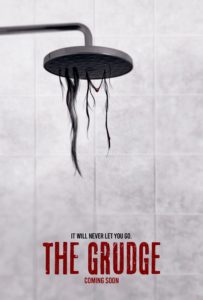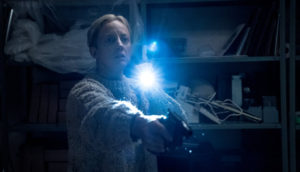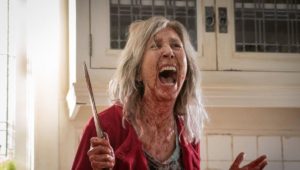 After Nicolas Pesce’s moody arthouse debut in 2016 with The Eyes of My Mother and his follow-up, Piercing—an adaptation of Japanese author Ryû Murakami’s novel, another American adaptation of the 2002 Japanese horror film, Ju-On: The Grudge seemed like an odd choice for a director who is grouped in with the auteurs of “elevated horror.” Under the direction of Pesce is a cast that that could get any avid horror fan in their seats with the likes of Andrea Riseborough (Mandy), Lin Shaye (Insidious franchise), John Cho (Searching), and some great character actors in Frankie Faison, William Sadler, and Demián Bichir. Everything about this film should work for even the most exacting fans of the genre. However, the film currently sits at what seems to be the lowest ranking within the wider Ju-On franchise according to Rotten Tomatoes.
After Nicolas Pesce’s moody arthouse debut in 2016 with The Eyes of My Mother and his follow-up, Piercing—an adaptation of Japanese author Ryû Murakami’s novel, another American adaptation of the 2002 Japanese horror film, Ju-On: The Grudge seemed like an odd choice for a director who is grouped in with the auteurs of “elevated horror.” Under the direction of Pesce is a cast that that could get any avid horror fan in their seats with the likes of Andrea Riseborough (Mandy), Lin Shaye (Insidious franchise), John Cho (Searching), and some great character actors in Frankie Faison, William Sadler, and Demián Bichir. Everything about this film should work for even the most exacting fans of the genre. However, the film currently sits at what seems to be the lowest ranking within the wider Ju-On franchise according to Rotten Tomatoes.
During my screening, the people down the row from me got up and one of them audibly said, “What the hell was that?” If that person had looked over at me right after the screen went black, they would have seen a satisfied smirk on my face. I went into the film expecting nothing; I had not seen any of the prior films. I came out of the theater in love. Everything about this film, even with its flaws (and there are some), worked for me and ended up being more enjoyable than a good portion of the horror I saw in 2019—which is most of my viewing each year. The sleepy tone and atmosphere of film, its crisp cinematography, and the film’s fatalistic bent felt more in line with the Asian horror cinema I have seen instead of ending on a high note like most American remakes tend towards.
 Most of the negative commentary surrounding the film seems revolve around the film’s ending, its frenetic pacing, and its overall dullness and lack of scares. That last complaint I will always throw out for being way too dependent on personal subjectivity. “Scary” is not a worthy descriptor for gauging the quality of a horror film. And one person’s “dull” is another person’s “enraptured.” If the reviewer relies only on these subjective notes for their review, then toss it out. It’s not a review, it’s indigestion.
Most of the negative commentary surrounding the film seems revolve around the film’s ending, its frenetic pacing, and its overall dullness and lack of scares. That last complaint I will always throw out for being way too dependent on personal subjectivity. “Scary” is not a worthy descriptor for gauging the quality of a horror film. And one person’s “dull” is another person’s “enraptured.” If the reviewer relies only on these subjective notes for their review, then toss it out. It’s not a review, it’s indigestion.
As for the ending and the pacing (or overall filmmaking), I can see legitimate critiques that could be made. The ending finds the heroine getting ready for work and getting her son off to school after burning the cursed house down. It feels like it might follow in a similar path as the last American remake. However, this comforting ending is subverted with a blunt jump scare followed by a cut to the front of our main character’s house and silence except for her screams and then the screen cuts to black. The end. It is blunt much like many of the deaths that punctuate the film’s landscape—many of them done practically. It seems that the ending only works for those who were on board with the film up to that point. If the audience was not immersed already, then the ending would probably feel pointlessly sudden. Those, like me, who were immersed in the story, characters, and the bleakness of the film’s tone probably won’t be bothered by Pesce’s hard cuts.
 As for the frenetic pacing (along with the Mindhunter-style title cards), this seems to be the most fascinating element of the film. Considering the film is set in the early 2000s, most of the cars, technology, and clothing feel deeply incongruous with the setting. It feels like we are in an alternate timeline where the technology and clothing of the late 80s and early 90s are still de jour in the new century. The seeming out-of-time quality of the film’s setting competes with the frenetic editing of Ken Blackwell and Gardner Gould. It’s this tension of rivaling timelines that continued to keep me on edge. Pesce does not allow his audience the courtesy of the typical building of tension and release. Sometimes the tension never releases, we just cut to a new scene. Other times, there is just a brutal death scene that is displayed without the requisite tension preparing us. He is intentionally rebelling against the rhythmic liturgy of most of the horror films that are released. It is these technical elements of how Pesce chose to make this film that ultimately kept me on edge throughout its runtime and made it easy for me to forgive the more formulaic moments that would periodically show up.
As for the frenetic pacing (along with the Mindhunter-style title cards), this seems to be the most fascinating element of the film. Considering the film is set in the early 2000s, most of the cars, technology, and clothing feel deeply incongruous with the setting. It feels like we are in an alternate timeline where the technology and clothing of the late 80s and early 90s are still de jour in the new century. The seeming out-of-time quality of the film’s setting competes with the frenetic editing of Ken Blackwell and Gardner Gould. It’s this tension of rivaling timelines that continued to keep me on edge. Pesce does not allow his audience the courtesy of the typical building of tension and release. Sometimes the tension never releases, we just cut to a new scene. Other times, there is just a brutal death scene that is displayed without the requisite tension preparing us. He is intentionally rebelling against the rhythmic liturgy of most of the horror films that are released. It is these technical elements of how Pesce chose to make this film that ultimately kept me on edge throughout its runtime and made it easy for me to forgive the more formulaic moments that would periodically show up.
Review| The Grudge (2020)
Previous articleSaying Farewell to a Decade of Farewells with The FarewellNext article Review| Underwater (2020)
